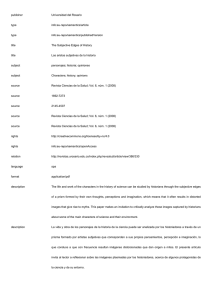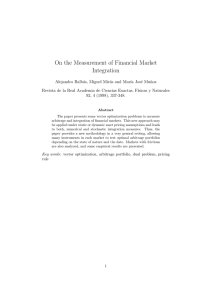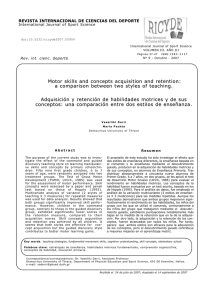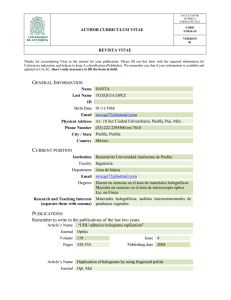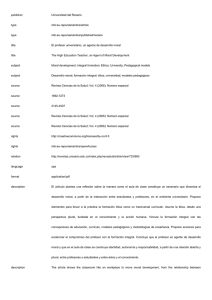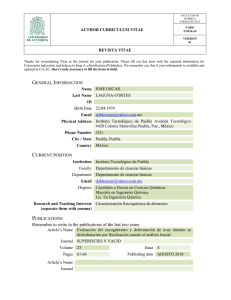Academic learning time in physical education(ALT
Anuncio
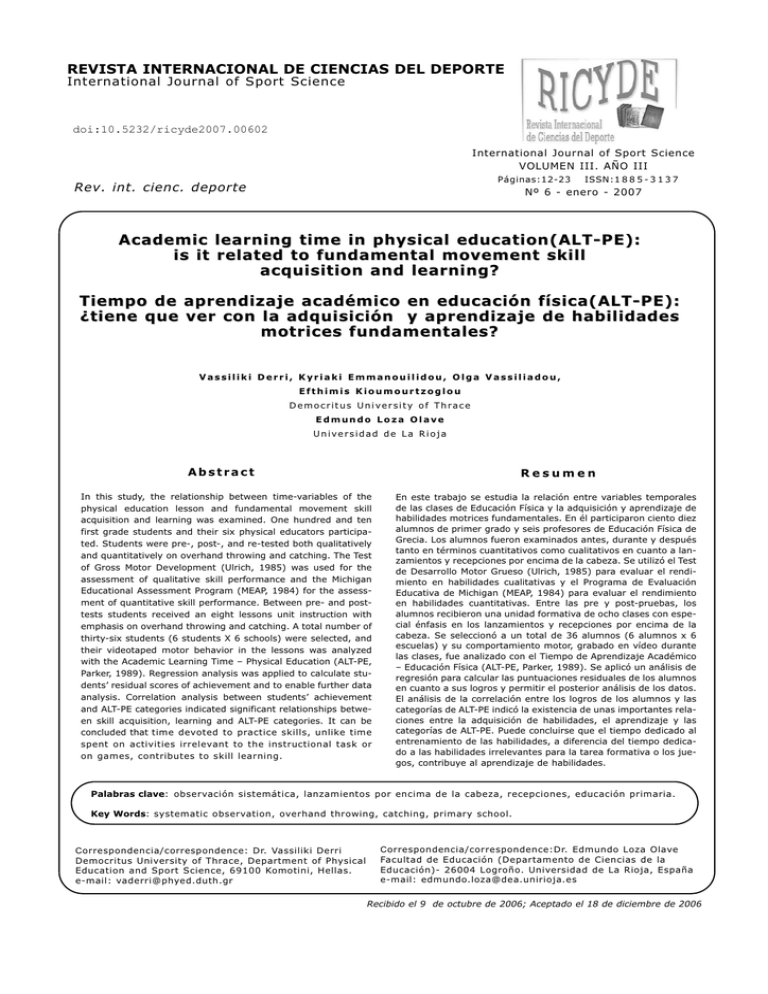
REVISTA INTERNACIONAL DE CIENCIAS DEL DEPORTE International Journal of Sport Science doi:10.5232/ricyde2007.00602 International Journal of Sport Science VOLUMEN III. AÑO III Páginas:12-23 Rev. int. cienc. deporte ISSN:1 8 8 5 - 3 1 3 7 Nº 6 - enero - 2007 Academic learning time in physical education(ALT-PE): is it related to fundamental movement skill acquisition and learning? Tiempo de aprendizaje académico en educación física(ALT-PE): ¿tiene que ver con la adquisición y aprendizaje de habilidades motrices fundamentales? Vassiliki Derri, Kyriaki Emmanouilidou, Olga Vassiliadou, Efthimis Kioumourtzoglou Democritus University of Thrace Edmundo Loza Olave Universidad de La Rioja Abstract Resumen In this study, the relationship between time-variables of the physical education lesson and fundamental movement skill acquisition and learning was examined. One hundred and ten first grade students and their six physical educators participated. Students were pre-, post-, and re-tested both qualitatively and quantitatively on overhand throwing and catching. The Test of Gross Motor Development (Ulrich, 1985) was used for the assessment of qualitative skill performance and the Michigan Educational Assessment Program (MEAP, 1984) for the assessment of quantitative skill performance. Between pre- and posttests students received an eight lessons unit instruction with emphasis on overhand throwing and catching. A total number of thirty-six students (6 students X 6 schools) were selected, and their videotaped motor behavior in the lessons was analyzed with the Academic Learning Time – Physical Education (ALT-PE, Parker, 1989). Regression analysis was applied to calculate students’ residual scores of achievement and to enable further data analysis. Correlation analysis between students’ achievement and ALT-PE categories indicated significant relationships between skill acquisition, learning and ALT-PE categories. It can be concluded that time devoted to practice skills, unlike time spent on activities irrelevant to the instructional task or on games, contributes to skill learning. En este trabajo se estudia la relación entre variables temporales de las clases de Educación Física y la adquisición y aprendizaje de habilidades motrices fundamentales. En él participaron ciento diez alumnos de primer grado y seis profesores de Educación Física de Grecia. Los alumnos fueron examinados antes, durante y después tanto en términos cuantitativos como cualitativos en cuanto a lanzamientos y recepciones por encima de la cabeza. Se utilizó el Test de Desarrollo Motor Grueso (Ulrich, 1985) para evaluar el rendimiento en habilidades cualitativas y el Programa de Evaluación Educativa de Michigan (MEAP, 1984) para evaluar el rendimiento en habilidades cuantitativas. Entre las pre y post-pruebas, los alumnos recibieron una unidad formativa de ocho clases con especial énfasis en los lanzamientos y recepciones por encima de la cabeza. Se seleccionó a un total de 36 alumnos (6 alumnos x 6 escuelas) y su comportamiento motor, grabado en vídeo durante las clases, fue analizado con el Tiempo de Aprendizaje Académico – Educación Física (ALT-PE, Parker, 1989). Se aplicó un análisis de regresión para calcular las puntuaciones residuales de los alumnos en cuanto a sus logros y permitir el posterior análisis de los datos. El análisis de la correlación entre los logros de los alumnos y las categorías de ALT-PE indicó la existencia de unas importantes relaciones entre la adquisición de habilidades, el aprendizaje y las categorías de ALT-PE. Puede concluirse que el tiempo dedicado al entrenamiento de las habilidades, a diferencia del tiempo dedicado a las habilidades irrelevantes para la tarea formativa o los juegos, contribuye al aprendizaje de habilidades. Palabras clave: observación sistemática, lanzamientos por encima de la cabeza, recepciones, educación primaria. Key Words: systematic observation, overhand throwing, catching, primary school. Correspondencia/correspondence: Dr. Vassiliki Derri Democritus University of Thrace, Department of Physical Education and Sport Science, 69100 Komotini, Hellas. e-mail: [email protected] Correspondencia/correspondence:Dr. Edmundo Loza Olave Facultad de Educación (Departamento de Ciencias de la Educación)- 26004 Logroño. Universidad de La Rioja, España e-mail: [email protected] Recibido el 9 de octubre de 2006; Aceptado el 18 de diciembre de 2006 Derri, V.; Emmanouilidou, K.; Vassiliadou, O.; Kioumourtzoglou, E. y Loza Olave, E. (2007). Academic learning time in physical education (alt-pe): is it related to fundamental movement skill acquisition and learning? Revista Internacional de Ciencias del Deporte. 6(3), 12-23. http://www.cafyd.com/REVISTA/art2n6a07.pdf Introduction O ne of the strongest designs to document teaching effectiveness concerns the processproduct research, which scope is to determine the relationship between teacher or student behavior (process) and student achievement (product) (Graham & Heimerer, 1981). Among the students’ behaviors that are considered important for learning is the time needed to learn a skill. Also, the amount of time a student is engaged with a subject at an appropriate level of difficulty is one of the variables that underlie successful teaching (Lee, 1996). As stated by Silverman (1991), time/mediating process-product research is similar to process-product research but it focuses on the use of time and on student behavior, rather than on the teaching method or on the teacher’s behavior. Research on teaching physical education has focused on the relationship of class organization and student engagement time-variables with achievement. Class time was described in three measures: a) allocated time; the time the teacher plans for students to be engaged in motor activities, b) engaged time; the time a student is actually physically engaged in the activities, and c) academic learning time (ALT); the portion of engaged time a student is involved in motor activity at an appropriate success rate (Parker, 1989). The lost time among the three measures is defined ‘funnel effect’ and reflects ‘how’ the teacher organizes the lesson time and designs appropriate activities for the students (Siedentop, 1991). Teacher and student behavior is documented through systematic observation, which involves an observation system to categorize behaviors, and requires direct observation of classes, usually by videotaping (Rink, 1998). Descriptive studies that took place in ’70s and ’80s concluded that allocated time fluctuated between 50-80% of the lesson time, while only in half of this time students were motor engaged. The remaining class time was spent on management and transition activities or on waiting to participate. ALT fluctuated between 1034% that is considered very low (i.e., Cousineau & Luke, 1990; Silverman, Devillier & Ramirez, 1991). A large number of time/mediating process-product studies investigated the relationship between student engagement and achievement. Although results were not always consistent, time appeared to be a promising variable for predicting achievement. Some investigators pointed out that academic learning time was related to student learning (i.e., Beckett, 1989; Silverman et al, 1991), while others indicated that the number of correct trials and not the engagement time was related to achievement (Ashy, Lee, & Landin, 1988). However, time spent in no instructional tasks, like transition or managerial activities, was negatively related with achievement. Similarly, the type of practice seemed to be important because scrimmage and game like situations were negatively related to learning (Silverman, 1991; Silverman et al, 1991). The participants in the aforementioned process-product studies were fourth to twelfth graders or college students, and the teaching goal was sport skill learning. In early elementary years, however, fundamental movement skill learning is one of the most important topics of the physical education curriculum. Practice, encouragement and instruction are essential for children to perform at a mature stage (Graham, Holt/Hale, & Parker, 1998). Although most 13 Derri, V.; Emmanouilidou, K.; Vassiliadou, O.; Kioumourtzoglou, E. y Loza Olave, E. (2007). Academic learning time in physical education (alt-pe): is it related to fundamental movement skill acquisition and learning? Revista Internacional de Ciencias del Deporte. 6(3), 12-23. http://www.cafyd.com/REVISTA/art2n6a07.pdf children have the developmental potential to achieve mature performance of fundamental skills by the ages seven to eight (Gallahue, 1996), many of them fail to learn them or perform lower than expected for both qualitatively (correct technique) and quantitatively (outcome). Considering the importance of fundamental movement skill learning in early elementary years and the lack of studies that focused on the relationship between time-variables of the lesson and their learning, this study was conducted in an attempt to investigate the relationship between ALT-PE categories and the acquisition and learning of overhand throwing and catching skills. It was hypothesized that there would a significant relationship between skill acquisition and learning, and ALT as well as other ALT-PE categories. Method Participants One hundred and ten first grade students (58 boys and 52 girls) ages 6.4 to 7.9 (M=6.9, SD=0.3) of six elementary schools, which were randomly selected from a greater sample of schools, and their six physical educators, participated. From this pool, and based on the physical educators’ opinion, 2 high-, 2 medium-, and 2 low skilled students of each physical education class (N=36), were chosen for observation. Measures Qualitative assessment. The Test of Gross Motor Development (Ulrich, 1985) was applied for the assessment of qualitative performance of overhand throwing and catching. Concerning throwing, children threw a tennis ball at a wall from a 25-feet distance, with the direction “throw the ball hard at the wall”. For the assessment of catching, students caught a gently thrown with a slight arc 8-inch sponge ball, from a 15-feet distance. The direction was “catch the ball with your hands”. Each skill was performed three times and each qualitative component was evaluated with one point if it was observed at least in two of the three trials. Otherwise, it was evaluated with zero. The total score for each skill was calculated by adding the points for each component, and varied from 0 to 4 points. Quantitative assessment. The Michigan Educational Assessment Program (MEAP, 1984) was used to assess the quantitative performance of the skills. The throwing test consisted of throwing a tennis ball from a 25-feet distance to a 20X10-feet rectangular target in the middle of which there was a 6-feet diameter circled target. Each child threw the ball three times, after a practice trial. If the ball hit anywhere within the rectangular and out of the circled target, 1 point was recorded, while if it hit in the circled target 2 points were recorded. For off-target throws students were graded with 0. Thus, the total score ranged from 0 to 6 points. In the catching test, the students were required to catch an 8-inch, sponge ball before touching the floor, from a 20 feet distance. Each student performed six trials, after a practice trial. The score was 1 point for each successful trial and 0 points for each unsuccessful. Each student performed six trials, after a practice trial. The score was 1 point for each successful trial and 0 points for each unsuccessful. So, the total score ranged from 0 to 6 points. 14 Derri, V.; Emmanouilidou, K.; Vassiliadou, O.; Kioumourtzoglou, E. y Loza Olave, E. (2007). Academic learning time in physical education (alt-pe): is it related to fundamental movement skill acquisition and learning? Revista Internacional de Ciencias del Deporte. 6(3), 12-23. http://www.cafyd.com/REVISTA/art2n6a07.pdf Observation Instrument. Students’ behavior was measured with the 1982 Revision of Academic Learning Time – Physical Education (ALT-PE), (Parker, 1989) observation instrument which uses a twelve second interval observation/record technique. A student was observed for the first 6 seconds of the interval and the next 6 seconds two decisions were made and recorded: a) for the context level (general, subject matter knowledge, subject matter motor), and b) for the learner involvement level (not motor or motor engaged). The intervals and their percentage in all categories and subcategories of the instrument were calculated. The intervals, in which the context level was subject matter motor and the learner involvement level was motor appropriate, were considered to be the amount of ALT. Procedure After skills’ explanation and demonstration by the researcher, children were pre-tested on both skills and their performance was videotaped. Then, the physical educators were asked to emphasize catching and overhand throwing for eight consecutive lessons, which were implemented during the regular school program, twice a week. Physical educators were allowed to use classes’ time any way they wished in order to assist students learn the two manipulative skills. A total of 48 lessons (8 lessons X 6 physical educators) were videotaped. The 36 chosen students wore pinafores to be ever identifiable on videotapes. The students were post-tested the day after the completion of the lessons, and re-tested ten days after. Videotaped lessons were analyzed with ALT-PE, by two trained observers. Their training was based on learning the behaviors categories and coding procedure, coding videotapes to identify ambiguous patterns, discussion of disagreements and coding separately, until interobserver agreement reached an 80% in all subcategories. The six target students from each school were observed in sequence. The first time interval was assigned to the first student, followed by the second, third, etc, and that order was repeated until the end of each lesson. A preprogrammed audiotape was used to provide observation and recording intervals. The number and percentages of intervals in each category and subcategory of the instrument were calculated for each school and the means were the independent variables. Dependent variables were the students’ qualitative and quantitative achievement in post and retention test measures. The mean of residual scores was calculated for each school and used for the correlation with ALT-PE percentages. Results Dependent samples t-test was used to determine improvement in performance of manipulative skills. Significant differences were found between pre- and posttest measures in qualitative performance of throwing (t100=6.8, p<.001), and quantitative (t100=3.7, p<.001) and qualitative (t100=4.1, p<.05) performance of catching. Also, significant differences were found between pre- and retention test measures in qualitative performance of throwing (t97=8.1, p<.001), and in qualitative (t98=7.3, p<.001) and quantitative (t98=5.1, p<.001) performance of catching. As a measure of each student achievement, residual scores were calculated for both movement skills. A posttest on pretest and a retention test on pretest regression equation were determined. Based on this equation, predicted scores were calculated (Silverman, 1988). The actual post and retention test scores minus the predicted scores were the residual acquisition and residual retention gain scores respectively. These scores were positive if student 15 Derri, V.; Emmanouilidou, K.; Vassiliadou, O.; Kioumourtzoglou, E. y Loza Olave, E. (2007). Academic learning time in physical education (alt-pe): is it related to fundamental movement skill acquisition and learning? Revista Internacional de Ciencias del Deporte. 6(3), 12-23. http://www.cafyd.com/REVISTA/art2n6a07.pdf performance was better than predicted, and negative if it was worse than predicted. Residual gain scores were selected because they partial out pretest skill level are reliable, uncorrelated with entry skill, and not subject ceiling effects (Cronbach & Furby, 1970; Silverman, 1988). School mean residual scores (Table 1) were used for subsequent correlation analysis. School Ν Pre-test Q/n Q/l Post-test Q/n Q/l Retention test Q/n Q/l Residual acquisition Q/n Q/l Residual retention Q/n Q/l Throwing 1st 15 2.7 0.8 2.7 1.8 3.1 1.8 0.2 0.2 0.6 -0.2 2nd 12 2.0 1.4 2.4 1.5 3.4 2.5 0.4 -0.4 1.1 0.3 3rd 20 2.2 1.1 2.0 1.9 1.8 2.2 -0.2 0.2 -0.5 0.3 4th 21 1.9 0.7 1.7 1.5 1.4 2.0 -0.5 -0.2 -0.6 0.1 5th 19 3.2 1.1 3.0 1.6 2.8 1.5 0.3 -0.1 -0.1 -0.5 6th 11 3.1 1.0 2.8 2.0 3.0 2.0 -0.1 0.3 0.2 -0.1 Total 98 2.5 0.9 2.3 1.7 2.4 2.0 0.0 0.0 0.0 0.0 Catching 1st 15 4.6 0.9 5.0 1.3 5.2 2.3 -0.1 -0.3 -0.1 0.2 2 nd 12 4.2 1.2 5.0 1.1 4.9 2.0 0.1 -0.5 -0.2 -0.1 3rd 20 4,6 1.5 5.2 2.3 5.1 2.7 0.2 0.3 -0.0 0.5 4th 21 4.6 1.2 5.0 2.1 5.4 2.2 -0.1 0.4 0.2 0.2 5th 19 4.4 1.3 5.1 1.4 4.7 1.3 -0.0 -0.3 -0.1 -0.8 6 th 11 4.7 1.8 5.1 2.4 5.5 2.3 -0.2 0.4 0.2 -0.1 Total 98 4.5 1.3 5.1 1.7 5.1 2.1 0.0 0.0 0.0 - 0.0 Table 1. Means for pre-, post- and retention tests, and residual acquisition and retention gain scores for quantitative (Q/n) and qualitative (Q/l) performance of throwing and catching. ALT-PE data A total number of 5544 intervals were coded for the 36 students. With respect to the context level, 48.12% of intervals coded in ‘subject matter motor’, and most of them were in ‘skill practice’ subcategory (M=27.8%). At learner involvement level, most intervals were observed in ‘not motor engaged’ category (M=80.44%), and in ‘waiting’ subcategory (M=38%). Of ‘motor engaged’ subcategories, ‘motor appropriate’ was that with the higher percentage of intervals (11.22%). In addition, 5.95% of time intervals were used for the ‘academic learning time-ALT’. The percentages for all ALT-PE instrument categories and subcategories are depicted in Table 2. The lost time between the three types of time (‘funnel effect’) is depicted in Figure 1. 16 Derri, V.; Emmanouilidou, K.; Vassiliadou, O.; Kioumourtzoglou, E. y Loza Olave, E. (2007). Academic learning time in physical education (alt-pe): is it related to fundamental movement skill acquisition and learning? Revista Internacional de Ciencias del Deporte. 6(3), 12-23. http://www.cafyd.com/REVISTA/art2n6a07.pdf ALT-PE categories Ν Context Level Μ (%) SD 6 6 6 6 6 6.60 23.13 1.77 8.92 40.61 3.92 5.91 1.12 7.86 8.08 6 6 6 6 6 6 3.35 6.65 1.47 0.00 0.00 11.47 5.14 2.47 0.66 0.00 0.00 6.72 6 6 6 6 6 27.80 5.15 13.92 1.45 48.12 11.40 8.10 10.50 1.58 11.58 6 6 6 6 6 6 1.18 38.03 1.55 29.10 11.30 80.42 1.36 7.98 1.43 8.91 6.61 11.24 Motor Appropriate Motor Inappropriate Supporting Total 6 6 6 6 11.22 5.63 2.38 19.12 5.38 4.13 2.14 10.81 ALT 6 5.95 3.58 General Content Management Transition Break Warm-up Total Subject Matter knowledge Technique Strategy Rules Social Behavior Background Total Subject Matter Motor Skill practice Scrimmage Game Fitness Total Learner Involvement Level Not Motor Engaged Interim Waiting Off-Task On-Task Cognitive Total Motor Engaged Table 2. Means (%) and standard deviations for ALT-PE categories. 17 Derri, V.; Emmanouilidou, K.; Vassiliadou, O.; Kioumourtzoglou, E. y Loza Olave, E. (2007). Academic learning time in physical education (alt-pe): is it related to fundamental movement skill acquisition and learning? Revista Internacional de Ciencias del Deporte. 6(3), 12-23. http://www.cafyd.com/REVISTA/art2n6a07.pdf 70 63,5 57,5 60 50,9 % time intervalls 50 46,4 40 36,1 34,3 36 motor subject matter motor engaged 27,5 30 ALT-PE 19,8 20 12,9 8,3 10 5,3 10,2 8,6 3,6 4,1 11,9 2,4 0 = Teachers Figure 1: Percentages of time intervals in ‘motor subject matter’, ‘motor engaged’ and ‘ALT’ categories (‘Funnel effect’). Correlations between ALT-PE categories with Achievement Pearson Product Moment correlation was used to determine possible correlations between residual scores (acquisition and retention gains) in qualitative and quantitative performance of each school and the percentages of intervals in ALT-PE categories and subcategories. The results indicated several correlations (Table 3). The most notable were the negative correlations between residual acquisition gain scores of quantitative skill performance and: a) transition (r=-.76, p<.05), b) scrimmage (r=-.81, p<.05), and c) waiting (r=-.77, p<.05). On the other hand, positive correlations were found between residual retention gains of quantitative throwing and subject matter motor (r=76, p<.05), and between qualitative throwing and technique (r=.84, p<.05). Furthermore, negative correlations were found between residual retention gains of quantitative throwing and a) transition (r=-79, p<.05) and b) strategy (r=-.74, p<.05), qualitative throwing and a) game (r=-.95, p<.001) and b) off-task (r=-.76, p<.05). Similarly, negative were the correlations between quantitative catching and waiting (r=-.72, p<.05), and qualitative catching and management (r=-.86, p<.05). 18 Derri, V.; Emmanouilidou, K.; Vassiliadou, O.; Kioumourtzoglou, E. y Loza Olave, E. (2007). Academic learning time in physical education (alt-pe): is it related to fundamental movement skill acquisition and learning? Revista Internacional de Ciencias del Deporte. 6(3), 12-23. http://www.cafyd.com/REVISTA/art2n6a07.pdf Acquisition Throwing ALT-PE categories(%) Quantity r Retention Catching Quality r Quantity r Throwing Quality r Catching Quantity r Quality r Quantity r Quality r Context Level Management Transition Break Warm-up General content total Technique Strategy Rules Social behavior Background Knowledge content total Skill practice Scrimmage Game Fitness Motor content total .14 -.76Ï .1 .05 -.45 -.21 -.18 .12 .06 -.13 -.23 -.01 -.28 .34 .13 -.23 .52 -.10 -.14 .16 -.22 -.79Ï -.33 .16 -.58 -.77Ï -.002 -.83Ï .36 -.14 -.56 .52 .00 -.28 .13 -.86Ï .03 -.75Ï .70 .19 -.37 -.68 -.30 - .34 -.27 -.37 - .63 .45 -.16 - .43 .48 -.01 - -.41 -.74Ï -.37 - .84Ï .33 -.34 - .19 .26 .19 - .32 .09 -.19 - -.57 .13 .64 .52 -.68 .50 .08 .45 .32 -.38 .41 .38 .59 -.63 .32 .39 -.54 -.01 .58 -.81Ï -.66 .68 -.47 -.37 .64 -.30 -.39 -.37 .62 -.32 .13 .61 .76Ï .76Ï -.52 -.95ÏÏ .75Ï -.17 -.46 .68 -.04 -.56 -.09 .19 -.26 -.52 .17 -.37 Learner Involvement Level Interim Waiting Off-task On-task Cognitive Not motor engaged total Motor appropriate Motor inappropriate Supporting Motor engaged total ALT Ï p<.05 ÏÏ .20 .49 .44 -.38 -.59 -.39 -.06 -.60 .07 .12 .13 -.03 -.23 -.77Ï .07 -.07 .64 .43 .03 -.66 -.45 .19 .53 .16 .20 -.03 -.07 -.27 -.68 -.67 .23 .09 -.76Ï .08 .52 -.08 .10 -.72Ï -.48 .22 .10 -.06 -.64 -.49 -.62 .62 .48 .15 .44 .19 -.56 -.22 .70 -.07 .05 -03 .08 -.11 -.29 .09 .41 .30 .25 -.14 .16 .28 .03 .06 -.43 -.47 .03 -.07 .54 .61 .25 .13 .25 .17 .02 -.06 .13 p<.01 .15 -.42 .11 .48 .25 .28 .05 Table 3. Correlations between quality and quantity in performance of throwing and catching with Alt-pe categories, in the acquisition and in the retention phase. Discussion The purpose of the present study was to determine the relationship between students’ achievement in qualitative and quantitative performance of manipulative skills and ALT-PE categories. Results indicated that students improved and retained their performance in throwing and catching after the eight-lesson unit, a finding that is consistent with previous studies (i.e., Gusthart, Kelly & Rink, 1997), even though the teaching goal was sport skills learning. 19 Derri, V.; Emmanouilidou, K.; Vassiliadou, O.; Kioumourtzoglou, E. y Loza Olave, E. (2007). Academic learning time in physical education (alt-pe): is it related to fundamental movement skill acquisition and learning? Revista Internacional de Ciencias del Deporte. 6(3), 12-23. http://www.cafyd.com/REVISTA/art2n6a07.pdf The way time was spent in the unit of eight lessons showed that almost half of the class time was devoted to no subject matter motor content, and predominantly in warm-up, managerial and organizational activities related to instruction. Also, despite the fact that teachers had planned for students to be motor involved in physical education activities (subject matter motor) in half lesson time, the latter participated in motor activities relevant to the goal of the setting (motor engaged) only at 1/5 of lesson time. The remaining time students waited for instructions or opportunity to respond. Regarding the basic time-concept, ALT, it was extremely low (only 6% of lesson time), and lower than that in previous descriptive studies (Cousineau & Luke, 1990; Silverman et al, 1991) in which it varied from 10% to 34%. The way teachers used the lesson time is similar to other studies (Siedentop, 1991). Furthermore, ‘funnel effect’, that is lost time between motor subject matter planned by teachers, students motor engaged, and academic learning time, seems to be higher than in earlier studies (Cousineau &Luke, 1990; Godbout et al., 1987; Silverman et al, 1991). Given the great amount of wasted time, it can be concluded that teachers in the present study had difficulty in managing and organizing the lesson time and in designing activities in which students experience success. The lack of relationship between time of practice at an appropriate level of difficulty (ALT) and student quantitative achievement is inconsistent with previous findings of Philips and Carlisle (1983) and Beckett (1989) even though they examined volleyball and badminton sport skills, respectively. On the other hand, the present results are in agreement with other researchers’ findings (Godbout et al., 1987; Silverman, 1985) who found no relation between qualitative or quantitative achievement and ALT, and suggested that it was the number and appropriateness of practice trials which predicted student achievement. The absence of relation between ALT and student achievement could be attributed a) to the low percentage of ALT, b) to the lack of emphasis on qualitative cues during practice, and c) not only to the low percentage of time teachers devoted to technique (3.35%), but also to that part of that information (38%) was incorrect. This element was not evaluated by the ALT-PE instrument but it was additionally measured by the researchers of this study. The absences and mistakes in the above teachers’ behaviors may substantiate the fact that in Hellas, physical education was included in the early elementary curriculum relatively recently. Therefore, participants in the present study were not well educated or were inexperienced to teach these skills and this reflected to the use of critical cues. Only a few relations were found between the rest subcategories of ALT-PE instrument and acquisition of the skills. Specifically, the acquisition of quantitative performance of throwing was negatively related to time for actions irrelevant to instructional goals, such as managerial and organizational activities (transition). With regard to quantitative performance of catching, the practice time devoted to refinement and extension of the skill in a setting that stimulates the one that it is actually applied (scrimmage), did not seem to assist first graders’ learning. This finding is in accordance with that of Silverman and his collogues (1991), who assumed that this kind of practice keep students in non engaged activities. Negative was also the relation between quantitative acquisition gains of catching and the subcategory of “learner involvement level” called 20 Derri, V.; Emmanouilidou, K.; Vassiliadou, O.; Kioumourtzoglou, E. y Loza Olave, E. (2007). Academic learning time in physical education (alt-pe): is it related to fundamental movement skill acquisition and learning? Revista Internacional de Ciencias del Deporte. 6(3), 12-23. http://www.cafyd.com/REVISTA/art2n6a07.pdf ‘waiting for the next instruction or opportunity to respond’. As Pangrazi (1997) reported, students learn little, if not anything, standing in line or waiting to return to an activity. Concerning the retention gains and ALT-PE subcategories, results show several positive and negative relationships. The retention of quantitative performance of throwing related positively with the class time in which the primary focus was on motor involvement in physical education activities (motor content). On the other hand, it related negatively to the time that children a) received information about plans of action (strategy), and b) were engaged in managerial and organizational activities (transition). For qualitative performance, retention gains for overhand throwing were positively related both with information about the physical form of the skill (technique) provided by the teacher, and to practice time aiming to skill development (skill practice). On the contrary, the above gains were negatively related to time student engaged to no activities or to irrelevant activities (off-task). Also, skill practice in a game or competitive setting (game) related negatively to learning the qualitative cues of throwing, perhaps due to poor class organization or supervision. In such a setting, students perform without intervention by the teacher, meaning without feedback, which is considered very important for skill learning. Also, qualitative retention gains of both skills were negatively related with the time spent to class business (management) or discussions of issues (break) unrelated to instruction. Negative relations between poor class management and qualitative acquisition of jumping and a novel gymnastic skill were found in previous studies of Carreiro and Pieron (1990) and Behets (1997), respectively. Based on the relationships found in the current study the hypothesis, that there would be significant relationships between fundamental skill acquisition, learning and ALT as well as other ALT-PE categories, was partially confirmed. In view of the relationships among ALT-PE categories and students’ achievement, it can be concluded that lesson time dedicated to activities unrelated to the purpose of the lesson, influence negatively acquisition and retention of fundamental manipulative skills. Furthermore, skill practice in situations similar to actual or to competitive game settings seems not to improve the skills’ qualitative components in early elementary school years. On the contrary, student motor engagement and teaching of cues enhance retention of quantitative and qualitative performance. Despite the small academic learning time and the little and often incorrect information that children received, they improved and retained their performance in both kills. But, even though significant, the improvement of qualitative performance was little, since students learned two of the four cues of throwing and catching. Based on the aforementioned findings, teacher education on applying positive discipline strategies, on reducing student inactive participation, and on planning activities that suit to children’s level in order to increase functional learning time, seems necessary. Teachers should also learn to place emphasis on the critical cues of fundamental movement skills, and be aware of the importance of their teaching in primary school, so as to become more effective. A follow up study on the use of time variables after teacher education would be interesting. Also, further research could compare the use of time by physical educators teaching fundamental skills in younger students and more complex skills in older students. 21 Derri, V.; Emmanouilidou, K.; Vassiliadou, O.; Kioumourtzoglou, E. y Loza Olave, E. (2007). Academic learning time in physical education (alt-pe): is it related to fundamental movement skill acquisition and learning? Revista Internacional de Ciencias del Deporte. 6(3), 12-23. http://www.cafyd.com/REVISTA/art2n6a07.pdf References Ashy, M.H., Lee, A.M. & Landin, D.K. (1988). Relationship of practice using correct technique to achievement in a motor skill. Journal of Teaching in Physical Education, 7, 115-120. Beckett, K.D. (1989). The effects of motor appropriate engagement ALT-PE (M) on achievement in a badminton skill during an experimental unit. The Physical Educator, 46(1), 36-40. Behets, D. (1997). Comparison of more and less effective teaching behaviors in secondary physical education. Teaching and Teacher Education, 13(2), 215-224. Carreiro Da Costa, F. & Pieron, M. (1990). Teaching Effectiveness: Comparison of more and less effective teachers in an experimental teaching unit. In T. Williams, L. Almond & A. Sparkes (Eds), Sport and Physical Activity: moving towards excellence (pp. 169-176). London: Chapman & Hall. Cronbach, L.J. & Furby, L. (1970). How we should measure ‘change’- or should we? Psychological Bulletin, 74(1), 68-80. Cousineau, W.J. & Luke, M.D. (1990). Relationships between teacher expectations and academic learning time in sixth grade physical education basketball classes. Journal of Teaching in Physical Education, 9, 262-271. Gallahue, D. (1996). Developmental physical education for today’s children. USA: Brown and Benchmark. Godbout, P., Brunell, J. & Tousignant, M. (1987). Who benefits from passing through the program? In G.T. Barrette, R.S. Feingold, C.R Rees & M. Pieron (Eds.), Myths, Models, & Methods in Sport Pedagogy, (pp. 183-198). Champaigh, IL: Human Kinetics. Graham, G., Holt/Hale, S.A., & Parker, M. (1998). Children Moving. A reflective approach to teaching physical education. USA: Mayfield Pub. Co. Graham, G. & Heimerer, E. (1981). Research on teacher effectiveness: a summary with implications for teaching. Quest, 33(1), 14-25. Gusthart, J.L., Kelly, I.W. & Rink, J.E. (1997). The validity of the qualitative measure of teaching performance scale as a measure of teacher effectiveness. Journal of Teaching in Physical Education, 16, 196-210. Lee, A.M. (1996). How the field evolved. In S.J. Silverman & C.D. Ennis (Eds.), Student Learning in Physical Education. Applying Research to Enhance Instruction (pp. 934). Champaign, IL: Human Kinetics. Michigan Educational Assessment Program (1984). Assessment Administration Manual: Physical Education. Lansing, MI: State Board of Education. Pangrazi, R. (1997). Dynamic Physical Education for Elementary School Children. Boston: Allyn and Bacon. Parker, M. (1989). Academic Learning Time-Physical Education (ALT-PE), 1982 Revision. In P. W. Darst, D. B. Zakrajsek & V. H. Mancini (Eds.), Analyzing Physical Education and Sport Instruction (pp. 195-206). Champaign, IL: Human Kinetics. Phillips, D.A. & Carlisle, C. (1983). A Comparison of Physical Education Teachers Categorized as Most and Least Effective. Journal of Teaching in Physical Education, 2, 55-67. Rink, J. (1998). Teaching Physical Education for Learning. NY: McGraw Hill. Siedentop, D. (1991). Developing Teaching Skills in Physical Education. CA: Mayfield. 22 Derri, V.; Emmanouilidou, K.; Vassiliadou, O.; Kioumourtzoglou, E. y Loza Olave, E. (2007). Academic learning time in physical education (alt-pe): is it related to fundamental movement skill acquisition and learning? Revista Internacional de Ciencias del Deporte. 6(3), 12-23. http://www.cafyd.com/REVISTA/art2n6a07.pdf Silverman, S. (1985). Students’ characteristics mediating engagement–outcome Relationships in Physical Education. Research Quarterly for Exercise and Sport, 56(1), 66-72. Silverman, S. (1988). Relationships of selected presage and context variables to achievement. Research Quarterly for Exercise and Sport, 59(1), 35-41. Silverman, S. (1991). Research on teaching in physical education. Research Quarterly for Exercise and Sport, 62(4), 352-364. Silverman, S., Devillier, R. & Ramirez, T. (1991). The validity of Academic Learning Time-Physical Education (ALT-PE) as a process measure of achievement. Research Quarterly for Exercise and Sport, 62(3), 319-325. Ulrich, D. (1985). Test of Gross Motor Development. Austin, TX: Pro-Ed. 23
